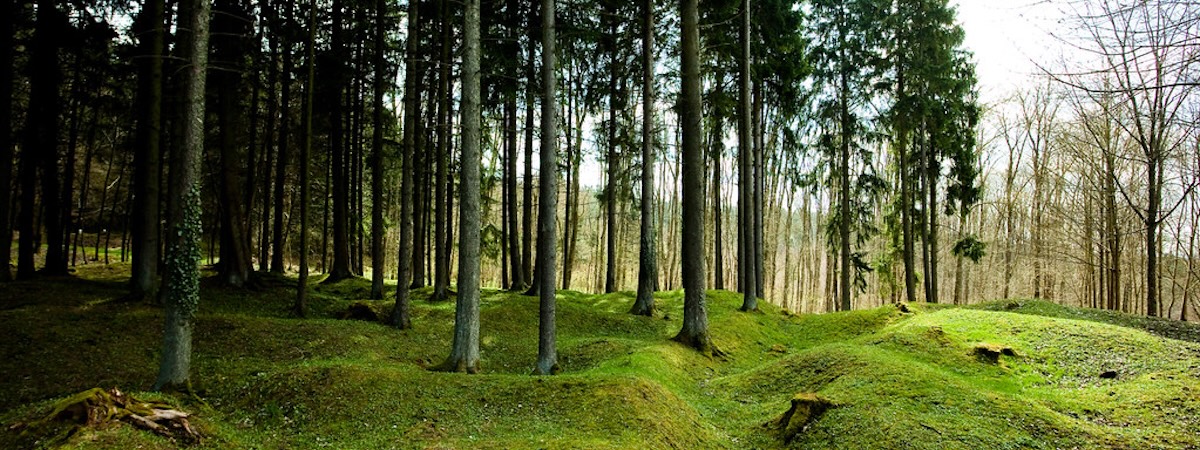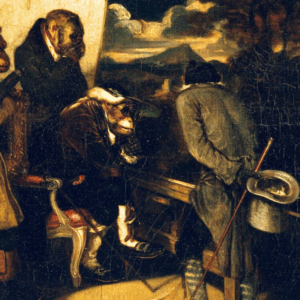
The WWI Battle That Never Ended: Finding Unexploded Mines in Verdun’s Fields
Michael Jerome Plunkett on France's De-miners and Discoveries While Writing a War Novel
I made a visit to Verdun, France in 2013 because I wanted to walk the fields of World War I’s longest and bloodiest battle. I’d heard craters made by the millions of artillery shells fired during the fighting could still be seen in every corner of the sprawling terrain. I was in town a little more than two hours on a stop from Luxembourg to Paris, just enough time for a bus tour ride and a walk around the necropolis.
A lifelong fan of military history, I found I knew very little about the first world war. Deep trenches and barbed wire, steel helmeted dough boys charging across No Man’s Land all came to mind but Verdun turned out to be something entirely different. Bombs of all kinds fired during the battle still rise from the earth there.
My tour guide told us things I’d never heard at any other battlefield. If we venture into the wooded areas, we shouldn’t stray off the paths, he said, we had to be careful where we stepped. Our safety could not be guaranteed. The old munitions, they were still out there and some of them were still alive. I noticed a sign during one of the brief bus tour stops. Red and weather faded, it read:
ATTENTION – DANGER
VISITEURS, CES RUINES SONT DANGEREUSES !
Visitors, these ruins are dangerous.
RESTEZ SUR LES SENTIERS BALISÉS
Do not proceed out of the marked lanes
ET SURVEILLEZ LES ENFANTS.
And watch over children.
N’OUBLIEZ PAS QUE LES ENGINS DE GUERRE
PEUVENT ENCORE TUER.
Do not forget that old war implements can still kill.
When I asked my guide if these signs were to be taken seriously, he nodded gravely and told me, Absolutely, with the utmost diligence. Farmers plowed up lead and iron shrapnel and even whole hand grenades by the pallet every harvest season. The government has an entire department of technicians called démineurs (literally de-miners) dedicated to disarming and disposing old war implements and they still couldn’t keep up with what was left behind.
So, it seemed, the war wasn’t really over. There I was, standing on a live battlefield.
So, it seemed, the war wasn’t really over. There I was, standing on a live battlefield. What a strange phenomenon. Do not forget that old war implements can still kill. The sentence’s restrained temperament with its eerie bureaucratic authority, quiet yet menacing.
I left town shortly after but Verdun remained fixed in my mind. I read all I could. I quickly came to find that the Battle of Verdun was more of an artillery duel than a conventional infantry battle. Sure, there were attacks and counterattacks and waves of soldiers traversing across No Man’s Land. Three quarters of the entire French Army spent time in Verdun.
But what everyone writes about is the artillery. Both sides fired tens of millions of shells nonstop over ten months. Some you could hold in your hand. Others were so large you could vanish behind one. They fired so many they lost count. No one knows the exact total.
The hills surrounding Verdun were literally reduced in height from the ferocity of the artillery barrages leveled against their slopes. They blasted and scorched topsoil until it disappeared. The explosions disinterred hastily buried bodies while burying other men alive. It destroyed trenches and supply lines leaving men cowering in cratered ditches, dying of thirst, licking rainwater from the brims of their helmets.
Entire villages vanished overnight. Thousands of residents fled their homes under falling snow and shell fire. Many never returned. Those who did found their homes unrecognizable. Fleury, once a village of 500, changed hands sixteen times. It was reduced to a white smear that could only be identified from the air.
Even years after the war ended, nothing would grow. Other sites of fierce fighting such as The Somme and Flanders quickly returned to their former selves. Verdun remained a scabbed moonscape, which some observed as a mark from God as the supreme example of “man’s inhumanity to man.”
Over 300,000 French and German soldiers were killed. That’s more than double the number of people killed by cancer in France in 2021. It’s higher than the number of people killed by cardiovascular disease and respiratory diseases combined in the same year. Of those 300,000, close to 100,000 were never recovered. Soldiers stationed in the area remarked on the wretched smell of decomposition well into 1917, a year after the battle ended.
Those remains still saturate the soil of the now quaint hills and regrown forests surrounding the salient that once proved so vital to preventing the invading German forces from reaching Paris. They find skeletons all the time. It may be a century before the land is considered cleansed. They’ve been saying that for nearly a century.
I read all of this and wondered what was it like to make a life in a place like this today? How does one live where the past has yet to calcify, where even the mortar holding myths together has yet to dry? How do you make a career cleansing these fields where the potential for death rests beneath each step?
I began writing a series of debrief reports in the voices of démineurs, the type of thing they might be obligated to file after the conclusion of a long shift. These reports became a short story and then swelled to something else.
Over and over again, I returned to the numbers to make sure I had them correct. They didn’t seem real. But the numbers never seem real. According to the Council on Foreign Relations’ Global Conflict Tracker, in the time since I began my novel in 2020 alone, six major wars have broken out across the globe with twenty-two other disputes and armed conflicts also occurring over various regions.
In there, among the crushed snail shells and bits of shrapnel, he has found work worth doing, work with real meaning.
A report by Doctors Without Borders released in January, 2025 states, “After more than fifteen months of Israel’s war on Gaza, nearly seventy percent of all structures in the Strip have been destroyed or damaged, along with 92 percent of all housing units.” Gaza has the highest number of children amputees per capita of the entire world.
Ukraine is now the world’s largest minefield. Over 86,000 shelling events since February of 2022. More than 40,000 civilian casualties with 11,000 of those being fatalities. The government of Ukraine estimated in February of 2025 that roughly 29% of the country, 174,000km2, is contaminated with unexploded ordnance.
The parallels with Verdun are difficult to miss and yet I want to look away all the same. If Verdun is any indicator, these estimates are conservative at best. Timelines creep ever longer, and budgets climb higher. The true cost of a city destroyed and then saturated by munitions might not be measured in the number of shells fired, dollars spent to rehabilitate, or even lives. The numbers are too large for a mind to hold except for the sense of loss.
I returned to Verdun a decade later in February of 2023. My packing list consisted of heavy sweaters and boots for the winter weather. The only other thing I brought was about two-hundred or so pages of a novel I had now been working on for years. Draft number three, growing larger and stranger every day.
It followed a group of present-day démineurs as they disarmed old bombs dropped a century before and reckoned with the lasting effects of war fought before any of their lifetimes. In the opening scene, a man takes a short cut through a forest and stumbles upon a live artillery shell which kicks off a chain of events that shape the lives of the characters involved.
I had written every draft almost entirely from my imagination and I was finally, after a few years, beginning to find the outer limits of that approach.
On my first day back in Verdun, I drove to the Ossuary where the bones of actual soldiers killed in the battle could be seen in the crypts below through knee-high viewing windows. I parked in the lot behind the Ossuary and wandered around, finding a path that led through a stretch of forest to the Trench of Bayonets monument.
I made sure to stay on the path. But about halfway through the woods, something caught my eye. A minor anomaly in the dense woodland wedged in the bank of a small brook. Had I happened to look the other way at that exact moment, I would have missed it. It wasn’t the color, but the shape. What I could see planted in the mud was molded and spherical in a way that was unmistakably manmade.
Future generations will bear witness. Not as an example of what to prevent but rather proof of existence for those who can no longer speak.
The natural world is unforgiving to intruders. Even the smallest foreign objects stand out. I stopped and squinted. Then I looked around to make sure I was alone and I stepped off the trail. I approached the anomaly carefully, leaning over to get a better look.
I couldn’t believe it. It was an artillery shell. And even stranger, this was exactly how my novel, a story I made up in my head, began. I nudged it with my toe. It moved a little. I gave it a light kick and out toppled the rest of it right into the brook. The nose cone of a French 75mm artillery shell, mostly intact. Ultimately harmless, this was the piece of the bomb that would ignite the charge in the main body of the projectile.
I picked it up and held it in my hand, turning it one way then another, marveling at a century’s worth of decay. I thought of all the photos I had seen of the Titanic at the bottom of the ocean, the way the railings and bulkheads swelled and bloated under the effects of the saltwater, microorganisms and bacteria eating away at its steel. The shell’s nose cone underwent a similar transformation in the mud. I was holding something just as sunken, corroded, pressurized.
The imagined land of my novel, the history, the real tools of war–all of these elements converged to a point of singularity in my hand. Some French gunner, now long dead, had lifted it from a crate, shoved it into the breech of a cannon and fired it during that horrible year of 1916. Over a hundred years later, with the reality of an abstract history brought to bear, came the realization that this could easily be any artillery shell from any war.
That moment punctured the membrane between past and present for me. To be a person who knows the joy of holding their newborn child for the first time while also knowing the heft of a 75mm artillery shell.
The waves of our joys and calamities, both collective and personal, lap on the same shore, one after another, crashing over one another without pause. I still think about how, after the war, they planted new trees knowing there were still bones in the soil, knowing they would continue to find unstable munitions for centuries.
Nine of the destroyed villages surrounding were never rebuilt. Their land was so polluted with ordnance and human remains that France declared them uninhabitable. Les Villages mort pour la France. The rubble was left in place, among the dead and unexploded shells, as monuments to war. Each village remains on record with a population of 0, represented by a committee of three. Anyone can visit.
Today, Haumont has life-size cardboard cutouts of its former residents. German bunkers sit vacant. An outer wall of a Church still stands in Ornes. One collapsed column lay scattered like vertebrae across the lush green grass where patrons once knelt in the stained-glass window’s iridescent light.
I wandered through all these ruins and more than once, reached down to pick up a shattered wall tile or shard of pottery on the lip of a grass carpeted crater—crafted by hands a century removed.
They may as well be the homes in Gaza or Kyiv or any other city caught in the midst of war. The French left these villages alone because, yes, there was and still is danger, but also to say we were here, once.
Future generations will bear witness. Not as an example of what to prevent but rather proof of existence for those who can no longer speak. It feels trite to think “Those who cannot remember the past are condemned to repeat it.” That’s obvious. The wars keep coming.
The deeper thing at risk of erasure are the ruins and the ghosts they provide. It is an easier way to imagine loss—something you can reach out and grab instead of an inconceivably large number written on a page of other large numbers.
The thing is, even if they manage to purge the earth of every single one of those war implements, everything that comes after is remade nascent and ahistorical. Ancestrally vacant. Humanity starts over. We set new foundations, we rebuild, and what follows might be a city with new lives, but it erases what came before.
Wars rarely end. More often, they change shape. They are carried in the souls of those who experienced them and they metastasize in the earth. They morph into new conflicts. The tools, unwelcome on our own planet, linger.
The seeds of bombs planted by soldiers long gone remain dormant but alive just beneath the surface and yet the land rejects them every day. They only germinate when they explode either in a pit controlled by the démineurs or in the plow of some unfortunate farmer. We need the reminders, in all their many forms.
The world moves on. But the people persist.
Guy Momper is the Chief of the Metz Demining Center which covers Verdun and the surrounding area. He is one of the many who have spent their entire professional life cleaning up after a war they weren’t even alive for. He popped up continuously in my research. Documentaries, books, articles.
Toward the end of one documentary, Guy relates a tragic incident in which two démineurs from his team were killed while rearranging a crate of unexploded artillery shells. “I was very affected because they were my friends. We had to move on. We had to start over again. We had to recreate bonds. It has not been easy at all. It was difficult because everyone experienced it differently.”
He tells this story while driving one of their trucks back from a disposal site. He drives one handed, his wrist commanding the steering wheel, his fingers dangling. His tone is even and unwavering.
Beneath the subdued manner, there is a quiet conviction. Here is an individual who witnessed the most graphic of deaths of two people he worked with day in and day out. By his own admission, they were completely dismembered by the explosion. His tone shouldn’t be mistaken for apathy.
He goes on, “But we had to put one foot in front of the other. That’s it. We recreated a group and we moved on. It does not stop me from loving this job and continuing the work that these people also loved. I won’t stop because I love what I do.” This is the perspective of someone who has turned away from a chaotic and increasingly cruel world.
But instead of throwing up his hands, he thrust them into the soil beneath his feet. In there, among the crushed snail shells and bits of shrapnel, he has found work worth doing, work with real meaning. His conviction comes through action. It comes not from looking at the vast expanse of the universe but what is right there in front of him.
Guy will not see the Verdun purged of unexploded ordnance in his lifetime. There’s too many shells, it’s too large a job. And yet there is a quiet fulfillment in removing one at a time. He’s found purpose under the weight of each one. In doing so, he has found the strength to keep going forward. Step by step. One foot in front of the other.
______________________________

Zone Rouge by Michael Jerome Plunkett is available via Unnamed Press.
Michael Jerome Plunkett
Michael Jerome Plunkett is a writer from Long Island. He served in the United States Marine Corps and worked as an EMT in South Carolina. He is the Co-founder and Executive Director of the Literature of War Foundation, a nonprofit dedicated to enriching the minds of those in uniform by providing access to exceptional literature and fostering meaningful discussions around military experiences, leadership, and the human condition. He hosts its podcast, The LitWar Podcast which has featured guests such as Elliot Ackerman, Phil Klay, and Emily St. John Mandel. He led the Patrol Base Abbate Book Club for veterans and hosted guests such as Sebastian Junger, Ocean Vuong, and Kaveh Akbar. He was a 2021 VCCA Fellow. He was a scholar in the 2024 Stand-To Veteran Leadership Program at the George W. Bush Presidential Center. He was a 2025 resident in the Edith Wharton Writing Residency. His writing has been published in The Wrath-Bearing Tree, The War Horse, Leatherneck Magazine, Coffee or Die, Dirtbag Magazine, and Lethal Minds Journal. Zone Rouge is his first novel.












